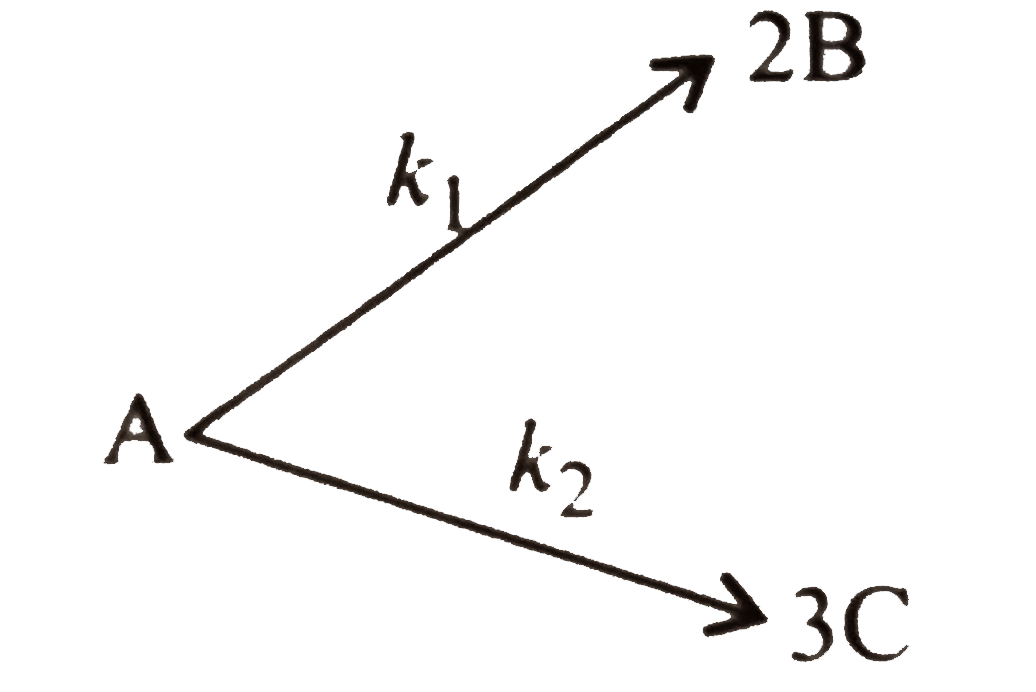Complete Solutions to Ex 4.3 (Objective) of chapter CHEMICAL KINETICS of Class 12 book with complete answers and questions
| Class 12 | CHEMISTRY |
| Chapter | CHEMICAL KINETICS |
| CENGAGE CHEMISTRY | Ex 4.3 (Objective) |
| Number Of Questions | 15 |
| Academic Year | 2023-24 |
Aqueous `AB_(2)` decomposes according to the first order reaction:
`AB_(2)(aq) rarr A(g) + 2B(l)`
After `20 min` the volume of `A(g) ` colledcted during such a reaction is `20 mL`, and that collected after a very long time is `40 mL`. The rate constant is :03:04View SolutionA plot of logarithm of rate vs logarithm of concentration of the reactant in a first order reaction is straight line whose slope is `tan theta`, where `theta` is
02:32View SolutionThe rate of radioactive decay of a sample are `3 xx 10^(8) dps` and `3 xx 10^(7) dps` after time `20 min` and `43.03 min` respectively. The fraction of radio atom decaying per second is equal to
03:31View SolutionConsider the following parallel reactions being given by `A(t_(1//2) = 1.386 xx 10^(2) hours)`, each path being first order.

If the distribution of `B` in the Product mixture is `50%`, the partical half life of `A` for converison into `B` is04:05View SolutionThe rate constant for forward reaction `A(g) hArr 2B(g)` is `1.5 xx 10^(-3) s^(-1)` at `100 K`. If `10^(-5)` moles of `A` and `100 "moles"` of `B` are present in a `10-L` vessel at equilibrium, then the rate constant for the backward reaction at this temperature is
03:55View SolutionThe rate law for a reaction between `A` and `B` is given by rate `= k[A]^(n)[B]^(m)`. On doubling the concentration of `A` and halving the concentration of `B`, the ratio of the new rate to the earlier rate of the reaction becomes
02:38View SolutionDuring the study of kinetics of chemical or nuclear reaction, `t_(1//3)` can be defined as
01:33View SolutionGadolinium-`153`, which is used to detect osteoporoiss, has a life of `242` days. After how many days, on an average, a nuclide can be conisdered absent form patient's system?
02:20View SolutionThe rate constant for the hydrolyiss of ethyl acetate in the presence of `0.1 N` acid `(A)` was found to be `5.4 xx 10^(5) s^(-1)` and for the hydrolyiss of ethyl acetate in the presence of `0.1 N` acid `(B)` , it was `6.2 xx 10^(-5) s^(-1)`. form these observations, one may conclude that
03:18View SolutionFor the reaction, `R-X overset(Slow)rarrR^(o+)+X^(o+)`,
`R^(o+) + overset(ɵ)(OH) overset("Fast") rarr ROH`
Which type of reaction coordinate diagram represents the above reaction mechanism?01:53View SolutionThe rate constant for zero order reaction is
02:09View SolutionGaseous cyclobutane isomerizes to butadiene in a first order process which has `k` value at `153^(@)C` of `3.3 xx 10^(-4) s^(-1)`. How many minutes would it take for the isomerization to proceeds `40%` to completion at this temperature ?
02:52View SolutionThe isomerization of cyclopropane to form propane is a first order reaction. At `760 K, 85%` of a sample of cyclopropane change to propane in `79 min`. Calculate the value of the rate constant.
02:06View SolutionThe converison of vinyl allyl ether to pent-`4`-enol follows first order kinetics. The following plot is obtained for such a reaction:

The rate constant for the reaction is04:05View SolutionCalculate the half life of the first-order reaction:
`C_(2)H_(4)O(g) rarr CH_(4)(g)+CO(g)`
The initial pressure of `C_(2)H_(4)O(g)` is `80 mm` and the total pressure at the end of `20 min` is `120 mm`.04:01View Solution
Ex 4.3 (Objective) questions and complete solutions for chapter CHEMICAL KINETICS of CENGAGE CHEMISTRY (HINGLISH) of Class 12
All Exercises from CENGAGE CHEMISTRY Class 12 CHEMISTRY CHEMICAL KINETICS
- Archives Fill In The Blanks
- Archives Integer
- Archives Multiple Correct
- Archives Single Correct
- Archives Subjective
- Archives True/False
- Ex 4.1 (Objective)
- Ex 4.2 (Objective)
- Ex 4.3 (Objective)
- Ex 4.3 More Than One Correct
- Ex4.4 Objective
- Exercises Assertion-Reasoning
- Exercises Fill In The Blanks
- Exercises Integer
- Exercises Linked Comprehension
- Exercises Multiple Correct
- Exercises Single Correct
- Exercises True/False
- Illustration
- Solved Example
